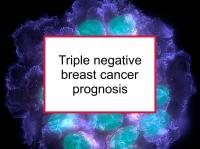Triple negative breast cancer is estrogen receptor negative (ER-), progesterone receptor negative (PR-), and human epidermal growth factor receptor 2 (HER2) negative. Although triple negative breast cancer is receiving a great deal of attention by researchers, there is little data concerning its prognosis according histological type.
Most triple negative disease takes the form of ductal breast cancer, however it can also have more rare histology. Now a new study has reported the relative survival outcomes of various histological types of triple negative breast cancer.
Histological types of breast cancer
Histology refers to the microscopic structure of tissues. Ductal and lobular carcinoma are the most common histological types of breast cancer. More rare are mucinous carcinoma, adenoid cystic carcinoma and mixed tumors that include tumor cells of more than one histological type. Within the category of ductal carcinoma are rare subtypes such as medullary carcinoma and metaplastic carcinoma.
Generally speaking, each of the histological types can have any combination of receptor status. For example, lobular breast cancer can have triple negative status, although it is far more likely to be ER+/PR+/HER2-.
Latest research reports triple negative survival by histological type
The study referenced at the beginning of this news article was designed to examine the survival outcomes of special types of triple negative breast cancer. To conduct the study, the authors identified 8,801 Stage I to Stage III breast cancer patients who received breast cancer surgery at the European Institute of Oncology during the period 1997 to 2005. At total of 781 of these women had triple negative breast cancer. The women were followed for a median of 5.7 years (range: 0 to 13 years).
Overall, the five-year breast cancer relapse-free survival rate was found to be 77% for triple negative breast cancer patients. The comparable percentages were 68% for HER2+, 95% for luminal A, and 84% for luminal B breast cancer. Luminal A and B are molecular phenotypes, which are determined by gene expression profiling.
Generally speaking, luminal A tumors are strongly ER+ and PR+, and HER2-, with low tumor grade and low proliferation. Luminal B tumors are weakly to moderately ER+/PR+ and can be HER2- or HER2+. Luminal B tumors may have low tumor grade, but with higher proliferation and DNA instability than luminal A. ER+/PR- and ER-/PR+ tumors are usually luminal B.
Among the triple negative breast cancer cases, 693 (89%) were classified as invasive ductal carcinoma, compared to 29 (3.7%) apocrine, 18 (2.3%) lobular, 10 (1.2%) adenoid cystic, and 10 (1.2%) metaplastic. Among ductal triple negative cases, the five-year breast cancer relapse-free survival was 77% and overall survival was 84%. This compares to 56% and 89% for metaplastic carcinoma cases. On the other hand both disease free survival and overall survival were 100% at five years for women with adenoid cystic and medullary triple negative tumors.
The authors conclude that the specific histotype of triple negative breast cancer may have prognostic implications and should be considered in determining treatment.
Please see our articles on triple negative pronosis, as well as ductal and lobular breast cancer for more information.
